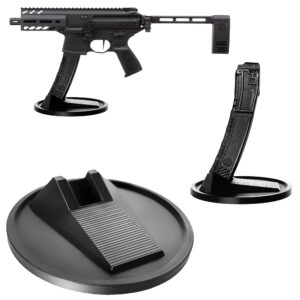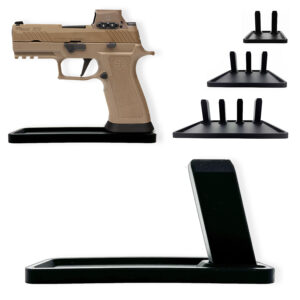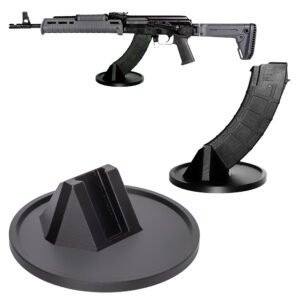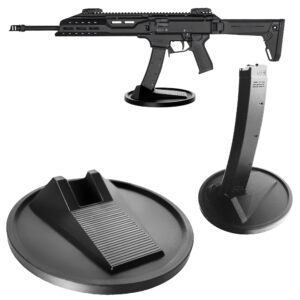
Categories:
The AR10, a versatile and powerful rifle designed primarily for long-range engagements, is a favored choice among shooting enthusiasts, hunters, and military personnel. One of its key components is the forward assist, a seemingly small yet crucial feature that ensures the reliable functioning of the gun. Understanding the forward assist’s role is essential for anyone looking to master the AR10 platform, whether for recreational use or professional applications.
The forward assist on the AR10 serves a specific purpose: to manually ensure the bolt carrier group (BCG) is fully seated into battery, which means it is correctly positioned to fire. This small, external button-like mechanism, located on the right side of the rifle, provides an additional safety and reliability measure for the shooter. It is particularly useful in situations where the rifle might fail to fully chamber a round due to various factors such as dirt, debris, or other obstructions that can affect the seamless operation of the gun.
When the shooter encounters a situation where the bolt does not fully lock into place, a simple press of the forward assist helps remediate the issue. The forward assist directly engages the notched edges of the bolt carrier, pushing it forward to make sure it is fully engaged with the chambered round. This action is also beneficial in preventing potential misfires or jams, contributing to the overall reliability of the rifle.
Moreover, the forward assist enhances the operational efficiency of the AR10 in adverse conditions. In environments where dust, sand, or other particulates are prevalent, the potential for malfunctions increases. The forward assist provides an immediate and effective way to mitigate these challenges, ensuring the AR10 maintains its functionality even in less-than-ideal circumstances, making it a valuable tool for military personnel operating in diverse terrains.
While some shooters may argue that the forward assist is not always necessary, it undeniably adds an extra layer of insurance to the operation of their gun. For those who prioritize reliability and readiness, the forward assist is a feature that should not be overlooked. Its inclusion on the AR10 not only demonstrates a commitment to precision and reliability but also underscores the importance of attention to detail in gun design.
Understanding the forward assist and utilizing it properly ensures that shooters can maintain optimal performance of their AR10, enhancing both confidence and safety in every shot taken.
The bolt carrier group (BCG) in an AR10 is undoubtedly one of the most crucial components of the gun, responsible for multiple functions that ensure its reliable operation. At its core, the BCG’s primary role is to facilitate the cycling process, which involves chambering, firing, extracting, and ejecting rounds. When the trigger is pulled, the firing pin within the BCG strikes the primer of the cartridge, igniting the propellant and causing the bullet to be fired.
The resulting gas pressure from the fired round pushes the BCG backward, initiating the extraction and ejection process, and ultimately chambering the next round from the magazine.
The BCG’s design is complex yet ingeniously simple, consisting of key parts such as the bolt, the carrier, the firing pin, the cam pin, and the gas key. The bolt, often considered the heart of the BCG, locks into the barrel extension to withstand the pressures of the fired round. The carrier surrounds the bolt and provides the inertia required to cycle the BCG during firing.
The gas key, attached to the top of the carrier, interacts with the gas tube to channel gas back into the carrier, driving the entire assembly rearward. This gas-driven mechanism is what makes semi-automatic and automatic fire possible.
The importance of a properly functioning BCG cannot be overstated. A malfunctioning BCG can lead to a myriad of issues ranging from failure to fire, failure to feed, or failure to eject, all of which can render the gun inoperative or unreliable. In the context of using the forward assist to push the bolt carrier group into battery, it becomes clear that the BCG must be fully seated and locked to ensure the AR10 can safely and effectively fire its next round.
The forward assist mechanism provides the necessary force to ensure the BCG is in the correct position, which is particularly useful in adverse conditions where dirt, grime, or fouling may impede normal operation.
In tactical or hunting scenarios, where reliability and quick follow-up shots are paramount, having a properly maintained and functioning BCG can be the difference between success and failure. Regular cleaning, inspections, and maintenance of the BCG are therefore essential practices for any AR10 user, ensuring the gun remains in peak operational condition. The BCG is thus not just a component but the lifeline of the AR10, integral to its performance and reliability.
The forward assist in an AR10 is a vital component that ensures the bolt carrier group (BCG) is fully seated into the battery position, thereby facilitating reliable firing of the rifle. The mechanism itself is a testament to thoughtful engineering aimed at enhancing the reliability and robustness of the gun, particularly under conditions where dirt, debris, or other impediments might prevent the BCG from fully cycling into place.
When a shooter encounters a situation where the bolt carrier group does not go fully into battery, perhaps due to fouling, environmental conditions, or minor stoppages, the forward assist provides a manual method to resolve this issue. This is crucial for maintaining functionality, particularly in tactical situations where reliability is non-negotiable. The forward assist mechanism is externally visible as a button or plunger located on the right side of the rifle, just rearward of the ejection port.
When activated, the shooter presses the forward assist plunger, which interfaces with the serrations on the side of the bolt carrier. The internal mechanics of the forward assist include a pawl that engages with the serrated surface of the bolt carrier, pushing it forward. This action forces the bolt carrier group fully into the chamber, ensuring the bolt rotates and locks correctly, achieving complete battery.
This manual intervention can be crucial for avoiding misfires or failure to fire situations, which could be detrimental in critical scenarios.
The utility of the forward assist becomes most apparent in adverse conditions where the rifle is subjected to dust, mud, or other environmental hazards that can impede its smooth operation. Situations such as these can lead to instances where the bolt does not completely chamber the round, leaving the rifle inoperative until the BCG is fully seated. By providing a method to manually lock the bolt into place, the forward assist ensures the weapon can continue firing without the need for disassembly or extensive clearing procedures.
Despite some debate within the shooting community about the necessity of the forward assist, particularly among those who keep their rifles meticulously clean and well-maintained, its presence remains a reassurance. In high-stress or combat environments, the forward assist adds an extra layer of reliability, ensuring the AR10 functions as needed regardless of less than ideal conditions. It represents a blend of mechanical precision and practical foresight, underscoring the AR10’s status as a versatile and dependable platform.
The forward assist is an integral component in the operation of the AR10 rifle, designed to ensure that the bolt carrier group (BCG) is fully seated into battery. Engagement of the bolt carrier group by the forward assist is crucial for the reliable function of the gun, particularly under conditions where dirt, debris, or carbon buildup might impede smooth cycling of the action.
When the bolt carrier assembly does not slide into the battery position completely, it can prevent the rifle from firing or result in a misfire. The forward assist is a situated prominently on the right-hand side of the receiver. It comprises a plunger and a pawl, which interact directly with the serrations on the bolt carrier. When the user manually presses the forward assist, the pawl moves forward, engaging with the notches on the bolt carrier.
This mechanical motion transfers force from the user’s hand directly to the bolt carrier, effectively pushing it forward until it is fully locked into the battery.
This mechanism is particularly useful in adverse conditions, such as in a combat or field environment, where contaminants are a common challenge. A partially seated bolt can lead to a failure to fire, extensively complicating a situation where timing is critical. By using the forward assist, a shooter ensures that the bolt carrier group achieves complete lock-up with the barrel extension, readying the rifle for the next shot.
The forward assist’s operation is straightforward but effective. When a round is chambered and the bolt carrier fails to go into battery, the shooter can apply pressure to the forward assist, and through a series of incremental pushes, each striking a different notch on the bolt carrier, it drives the bolt fully forward. This manual intervention thus ensures the reliability of the AR10 during critical times.
Ease of use and reliability are key attributes of the forward assist. Despite advancements in gun technologies that have improved the general reliability of the AR10 platform, the forward assist remains a vital feature, particularly appreciated by military personnel and enthusiasts who may operate their rifles in challenging environments. Its fundamental role in mechanical engagement underscores its importance in the overall design and functionality of the rifle, ensuring performance and dependability when they are most needed.
The addition of a forward assist on AR10 rifles offers several compelling benefits, which can significantly enhance the performance and reliability of the gun, especially in challenging conditions. One primary advantage is ensuring that the bolt carrier group (BCG) is fully seated into battery, which is crucial for the gun’s safe and effective operation. When the BCG isn’t fully in position, the rifle may fail to fire or could potentially cause a misfire, which can be dangerous.
By using the forward assist, shooters can manually push the BCG forward, ensuring it locks into place and the rifle is ready to fire. This added measure can be particularly crucial in combat or self-defense scenarios where every shot counts.
Another significant advantage of the forward assist is its utility in dirty or adverse environments. AR10 rifles, like any gun, can be susceptible to malfunctions caused by dirt, mud, sand, or other debris. In such situations, the BCG might not move entirely into battery on its own. The forward assist provides a manual solution to this problem, allowing the shooter to ensure their weapon is operational regardless of the external conditions.
This feature is particularly valued in military and law enforcement contexts, where guns can be exposed to harsh environments and reliability is paramount.
The forward assist also provides an additional layer of confidence and assurance for the shooter. Knowing that there is a method to ensure the complete cycling of the gun can instill greater confidence, especially for those who use their rifles in high-stress situations. This can lead to improved overall performance and quicker recovery from potential jams or misfeeds.
Furthermore, the forward assist can be incredibly helpful during silent loading. In situations where stealth is essential, the ability to lock the BCG silently without the usual noise from releasing the bolt catch can be a considerable tactical advantage. This ability can be crucial for hunters, special operations personnel, or anyone needing to maintain a low profile.
In conclusion, the forward assist on AR10 rifles provides numerous benefits, including guaranteeing the BCG is in battery, ensuring functionality in adverse conditions, offering peace of mind, and enabling silent loading. These advantages collectively enhance the reliability, functionality, and tactical utility of AR10 rifles, making the forward assist a valuable feature in a range of scenarios.
Using the forward assist on an AR-10 to ensure the bolt carrier group is fully in battery is a straightforward but crucial action. When firing an AR-10, there may be occasions when the bolt carrier group does not completely chamber a round. This can happen due to several reasons such as fouling, debris, or simply difficult environmental conditions. When this occurs, the forward assist serves as a mechanical intervention to push the bolt carrier group fully forward, ensuring the gun is ready to fire safely and reliably.
The first step is to visually and physically inspect your AR-10 to verify that it is not in a critical or dangerous position, especially if you have experienced a failure to fire or a misfeed. Ensure that the safety is engaged and point the muzzle in a safe direction. If a round is partially chambered but the bolt carrier group is not in the correct position, identify that the gun has not been fully cycled but there is no immediate danger.
Firmly grasp the handle of your rifle with your dominant hand, maintaining control at all times. Locate the forward assist, which is prominently situated on the right-hand side of the receiver, near the bolt carrier. Use your thumb to apply forward pressure on the forward assist button. The forward assist is designed to engage the serrations on the bolt carrier group, allowing you to manually push it into the proper position by repeatedly pressing the button if necessary.
Each press of the forward assist should be deliberate and steady. You will often feel a tactile difference when the bolt carrier group finally seats properly into battery. This sensation confirms that the bolt has rotated and locked into place, aligning correctly with the chambered round. If resistance is excessive and the bolt does not seat, remove the magazine and attempt to extract the round before trying again, as forcing the bolt forward might cause damage or create a potentially unsafe situation.
If the bolt carrier group locks into place, conduct a final check on the gun’s condition. Visually verify that the ejection port is properly closed and that the bolt carrier group is indeed fully forward. You are now ready to resume normal operation of the rifle. Unfasten the safety if you are preparing to fire. Using the forward assist may seem like a minor step, but it secures the integrity and functionality of your AR-10, enabling safe and effective use in critical moments.
When dealing with the forward assist mechanism on an AR10 rifle, several issues can arise that may impede its proper functioning. A common problem that shooters encounter is the forward assist failing to push the bolt carrier group fully into battery, which can result in a failure to feed or a failure to fire. To troubleshoot this issue, one must first understand the potential causes and how to effectively address them.
A primary cause of forward assist malfunction is excessive fouling or debris in the chamber or on the bolt carrier group. AR10 rifles, especially when subjected to rigorous or outdoor conditions, can accumulate dirt, carbon buildup, and other contaminants that hinder the smooth operation of the bolt carrier group. To resolve this, a thorough cleaning of the rifle is necessary. Disassemble the bolt carrier group and meticulously clean it with appropriate solvents and brushes, ensuring all carbon deposits and debris are removed.
Pay special attention to the forward assist pawl and spring to ensure they are free of obstruction.
Another potential issue can be a worn-out or damaged forward assist mechanism itself. If the forward assist pawl is worn down or the spring is weakened, it may not have enough force to push the bolt carrier group fully into battery. In this case, inspecting these components for wear and tear is crucial. If any parts are found to be defective, they should be replaced with quality replacements to ensure reliable performance.
While replacing parts, it is also a good practice to check the alignment and engagement between the forward assist pawl and the notches on the bolt carrier group to ensure proper function.
Ammo-related issues can also contribute to forward assist problems. If ammunition is not within specification or if cases are dirty or corroded, the bolt carrier group might not seat correctly. Using high-quality, clean, and well-maintained ammunition can alleviate some of these troubles. Inspecting ammo for any irregularities before loading can save significant effort in the field.
Operational technique might be the simplest yet overlooked aspect. Ensure that the user is applying firm, consistent pressure when engaging the forward assist. Gentle or inconsistent pressure might not provide the necessary force to seat the bolt carrier group correctly.
In conclusion, addressing forward assist issues in an AR10 largely involves a combination of proper maintenance, part inspection, and correct operational techniques. By systematically examining and addressing these areas, most common issues can be effectively resolved, thereby enhancing the reliability and performance of the rifle.








Colt
Colt M4 Carbine
Colt LE6920
Colt AR-15 A4
Daniel Defense
DDM4 V7
DDM4 V9
DDM4 V11
DDM4 ISR (Integrally Suppressed Rifle)
Smith & Wesson (S&W)
M&P15 Sport II
M&P15 Tactical
M&P15T
Bravo Company Manufacturing (BCM)
BCM Recce-16
BCM Recce-14
BCM MCMR Series
Aero Precision
M4E1 Series
AC-15
AR15 Pistol (Various Configurations)
Ruger
Ruger AR-556
Ruger SR-556
Ruger AR-556 MPR (Multi-Purpose Rifle)
Springfield Armory
Saint Victor
Saint Edge
Saint AR-15
PSA (Palmetto State Armory)
PSA PA-15
PSA AR-V
PSA Jakl (AR Pistol)
FN America
FN 15 Tactical Carbine
FN 15 Patrol
FN 15 DMR
Wilson Combat
Recon Tactical
Super Sniper
Protector Carbine
SIG Sauer
SIG M400 Tread
SIG M400 Elite
SIG M400 SDI
LWRC International
IC DI (Direct Impingement)
IC SPR
IC A5
Bushmaster Guns
XM-15 QRC
Bushmaster MOE
XM-15 Patrolman
Rock River Arms
LAR-15 Entry Tactical
LAR-15 Predator
LAR-15 Elite Comp
Stag Arms
Stag 15 Tactical
Stag 15L (Left-Handed Models)
Stag 15 Valkyrie
Noveske Rifleworks
Noveske Gen 4 N4
Noveske Space Invader (AR Pistol)
Noveske Recon
Anderson Manufacturing
AM-15 Optic Ready
AM-15 M4 Carbine
AM-15 Precision Rifle
Adams Arms
AA-15 Piston Rifle
P2 AARS (Adams Arms Rifle Series)
Black Rain Ordnance
SPEC15 Series
BRO Predator
Fallout 15
Diamondback Guns
DB15 Series
DB15CCMLB
DB15EB
Del-Ton Inc.
DTI-15
Del-Ton Echo 316H
Sierra 316M
Windham Weaponry
Windham SRC
Windham VEX-SS
Windham RMCS-4 (Caliber Conversion System)
Christensen Arms
CA-15 G2
CA-15 Recon
CA-15 Titanium Edition
Patriot Ordnance Factory (POF-USA)
Renegade Plus
P415 Edge
Revolution DI
LaRue Tactical
PredatAR
OBR (Optimized Battle Rifle)
LaRue Stealth 2.0
Battle Arms Development
Workhorse Patrol Carbine
BAD556-LW (Lightweight)
Authority Elite Rifle
Faxon Guns
Ascent AR-15
FX-19 (AR Pistol)
Streamline Ultralight Series
KE Arms
KE-15 SLT (Super Lightweight Tactical)
KE-15 Scout Carbine
Primary Weapons Systems (PWS)
MK1 MOD 2-M
MK116 PRO
MK107 (Piston AR Pistol)
ZEV Technologies
ZEV Core Elite Rifle
ZEV AR15 Billet Rifles
Franklin Armory
BFSIII AR-C1
Militia Model
F17-L (Chambered in .17 WSM)
Seekins Precision
SP15 DMR
NX15 Skeletonized Rifle
Havak Bravo
Aero Precision (Additional Models)
EPC-9 (Pistol Caliber ARs)
VG6 AR Rifles
Barrett Guns
REC7 DI
REC7 Gen II
CMMG
MK4 RCE
Resolute 300
Banshee (AR Pistol)
DPMS Panther Arms
Panther Oracle
Panther LR-308
H&K (Heckler & Koch)
HK MR556A1
HK416 (Military Variant)
Rock Island Armory (Armscor)
VR-80 Tactical AR (Shotgun AR Platform)
Troy Industries
Troy SPC-A3
Troy PAR (Pump Action AR)
Wilson Tactical
Tactical Recon AR
Protector Series
F1 Guns
FDR-15 Skeletonized Rifle
BDRx-15 Series
Juggernaut Tactical
JT-15
JT-10 Precision Rifle
AeroSurplus
Surplus AR-15 Rifles (Budget Models)
Thunder Tactical
AR-15 Basic Carbine
Tactical Builder Sets
Radical Guns
RF-15
Forged AR-Series
Dark Storm Industries
DS-15 Featureless Rifles
DS-10 Typhoon
DRD Tactical
Paratus
Aptus AR Rifles
Bear Creek Arsenal
BCA-15
AR Complete Upper Builds
Aero Survival Rifles (ASI)
ASR Tactical Series
Tactical Edge
WARFIGHTER Series
AR-15 Lightweight Rifles
Lone Star Armory
TX15 DMR
TX15 Carbine
HERA Arms
HERA H7
HERA AR-15 Lower Builds
IWI (Israeli Weapon Industries)
Zion-15
DRD Tactical
Tactical Modular Rifles
Quick-Takedown Rifles
V Seven Weapons
1776 Rifle
Hyperlite Rifle
Core Rifle Systems
Core15 Tac III
Core15 Patrol Rifle
Armalite (Original AR-15 Creator)
M15 Tactical
M15 A4 Carbine
DEF15 (Defensive Sporting Rifle Series)
PSA (Palmetto State Armory Additional Models)
PSAK-47 Hybrid (AR-AK Style Hybrid)
PSA Dagger (Pistol Caliber Configurations)
Odin Works
OTR-15
Odin Recon Rifle
Maxim Defense
MDX-508 PDX (Compact AR Pistol)
MDX-510 Rifle